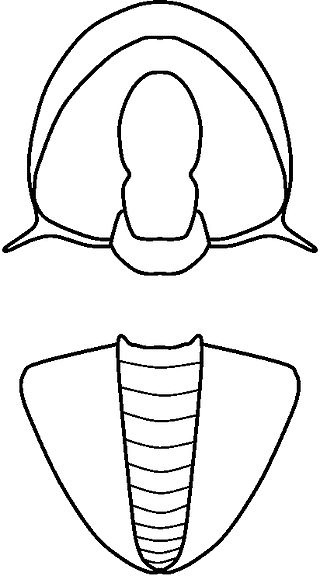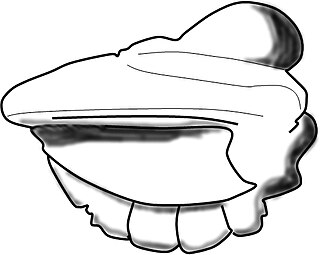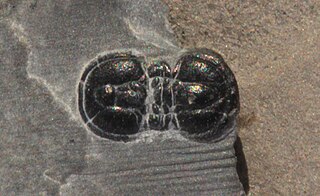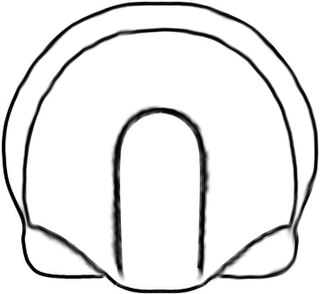
Trilobites are extinct marine arthropods that form the class Trilobita. Trilobites form one of the earliest known groups of arthropods. The first appearance of trilobites in the fossil record defines the base of the Atdabanian stage of the Early Cambrian period and they flourished throughout the lower Paleozoic before slipping into a long decline, when, during the Devonian, all trilobite orders except the Proetida died out. The last trilobites disappeared in the mass extinction at the end of the Permian about 251.9 million years ago. Trilobites were among the most successful of all early animals, existing in oceans for almost 270 million years, with over 22,000 species having been described.

Agraulos is a genus of Solenopleuridae trilobites that lived during the Middle Cambrian in North America and Europe, particularly the Czech Republic. The genus was named by Hawle & Corda in 1847.

Acontheus is a genus of trilobites belonging to the family Corynexochidae, order Corynexochida, and is geographically widespread having been recorded from middle Cambrian strata in Sweden, Newfoundland, Germany, Siberia, Antarctica, Queensland, China and Wales.
Abakania is an extinct genus of corynexochid trilobite in the family Corynexochidae. It lived during the Botomian stage, which lasted from approximately 524 to 518.5 million years ago. This faunal stage was part of the Cambrian Period.

Acidiscus is a genus of eodiscinid trilobite belonging to the family Weymouthiidae Kobayashi T. (1943), Order Agnostida Salter (1864). It lived during the Botomian stage = late Lower Cambrian Stage 4 ; the upper Botomian boundary corresponds to base of the Middle Cambrian, Miaolingian Series and Wuliuan stage.

Chelediscus is a genus of Eodiscinid trilobite belonging to the family Weymouthiidae Kobayashi T. (1943), Order Agnostida Salter (1864). The Treatise assigns this genus to the Calodiscidae; Cotton and Fortey (2005) however move it to the Weymouthiidae. Chelediscus lived during the later part of the Botomian stage.
Parabadiella is an extinct genus from a well-known class of fossil marine arthropods, the trilobites. It lived during the late Atdabanian stage, which lasted from 530 to 524 million years ago during the early part of the Cambrian Period.

Encrinurus is a long-lived genus of phacopid trilobites that lived in what are now Africa, Asia, Australia, Europe, North America, and South America from the middle Ordovician to the early Devonian from 472 to 412.3 mya, existing for approximately 59.7 million years.

Salterella is an enigmatic Cambrian genus with a small, conical, calcareous shell that appears to be septate, but is rather filled with stratified laminar deposits. The shell contains grains of sediment, which are obtained selectively by a manner also observed in foramanifera. The genus was established by Elkanah Billings in 1861, and was named after the English palaeontologist John William Salter.
Acmarhachis is a genus of trilobites in the order Agnostida, which lived in what are now Australia, Canada, China (Anhui), Kazakhstan, Russia (Kharaulakh), and the US. It was described by Resser in 1938, and the type species is Acmarhachis typicalis.
Zacanthoides is an extinct Cambrian genus of corynexochid trilobite. It was a nektobenthic predatory carnivore. Its remains have been found in Canada, Greenland, Mexico, and the United States. Its major characteristics are a slender exoskeleton with 9 thoracic segments, pleurae with long spines, additional spines on the axial rings, and a pygidium that is considerably smaller than its cephalon.
Repinaella is an extinct genus from a well-known class of fossil marine arthropods, the trilobites. It lived during the late Atdabanian stage.

Ptychagnostidae is a family of agnostid trilobites from the 5th Stage to the Paibian Age of the Cambrian. The family includes several important index fossils.

Mallagnostus Howell, 1935, is a trilobite genus belonging to the family Weymouthiidae Kobayashi T. (1943), Order Agnostida Salter (1864) according to Whittington et al. 1997. It lived during the late Lower Cambrian, with remains found in USA, Canada (Newfoundland), Spain, England, Russia, Mongolia, and the early Middle Cambrian as reported from China and Russia (Yakutia).

Pleuroctenium is an agnostid trilobite belonging to the family Condylopygidae Raymond (1913). The genus occurs in Middle Cambrian (Drumian) strata of Canada, the Czech Republic, England and Wales, France, and Sweden.
Tannudiscus Pokrovskaya (1959) is a genus of eodiscinid trilobites belonging to the family Weymouthiidae Kobayashi T. (1943), Order Agnostida. It lived during the late Lower Cambrian, with remains found in Canada (Newfoundland), China (Gansu), The United Kingdom (England), and the Russian Federation.

Kendallina is a genus of parabolinoidid trilobite with an inverted egg-shaped outline, a wide headshield, small eyes, small deflected spines, 12 thorax segments and a small, short tailshield. It lived during the Late Cambrian in what are today Canada and the United States.

Serrodiscus Richter and Richter 1941. is a genus of eodiscinid trilobite belonging to the family Weymouthiidae Kobayashi T. (1943), Order Agnostida. It lived during the late Lower Cambrian, with remains found in Canada, China (Gansu), The United Kingdom (England), Germany (Silesia), Poland, the Russian Federation, and the United States. It is named for the spines on the ventral side of the pygidium, which give it a serrated impression.

Bailiaspis Resser, 1936, is a Middle Cambrian (Miaolingian) trilobite genus belonging to the Family Conocoryphidae Angelin, 1854. Within the Acado-Baltic region, the genus ranges from Wuliuan into Guzhangian age strata.
Calodiscus is a genus of Eodiscinid trilobite in the family Calodiscidae. It lived during the late Lower Cambrian, with remains found in Canada, the United States, Greenland, The United Kingdom (England), Sweden, France, Germany, Italy (Sardinia), Kazakhstan, the Russian Federation and China.












